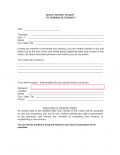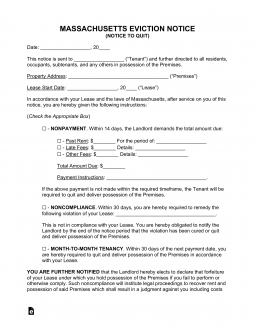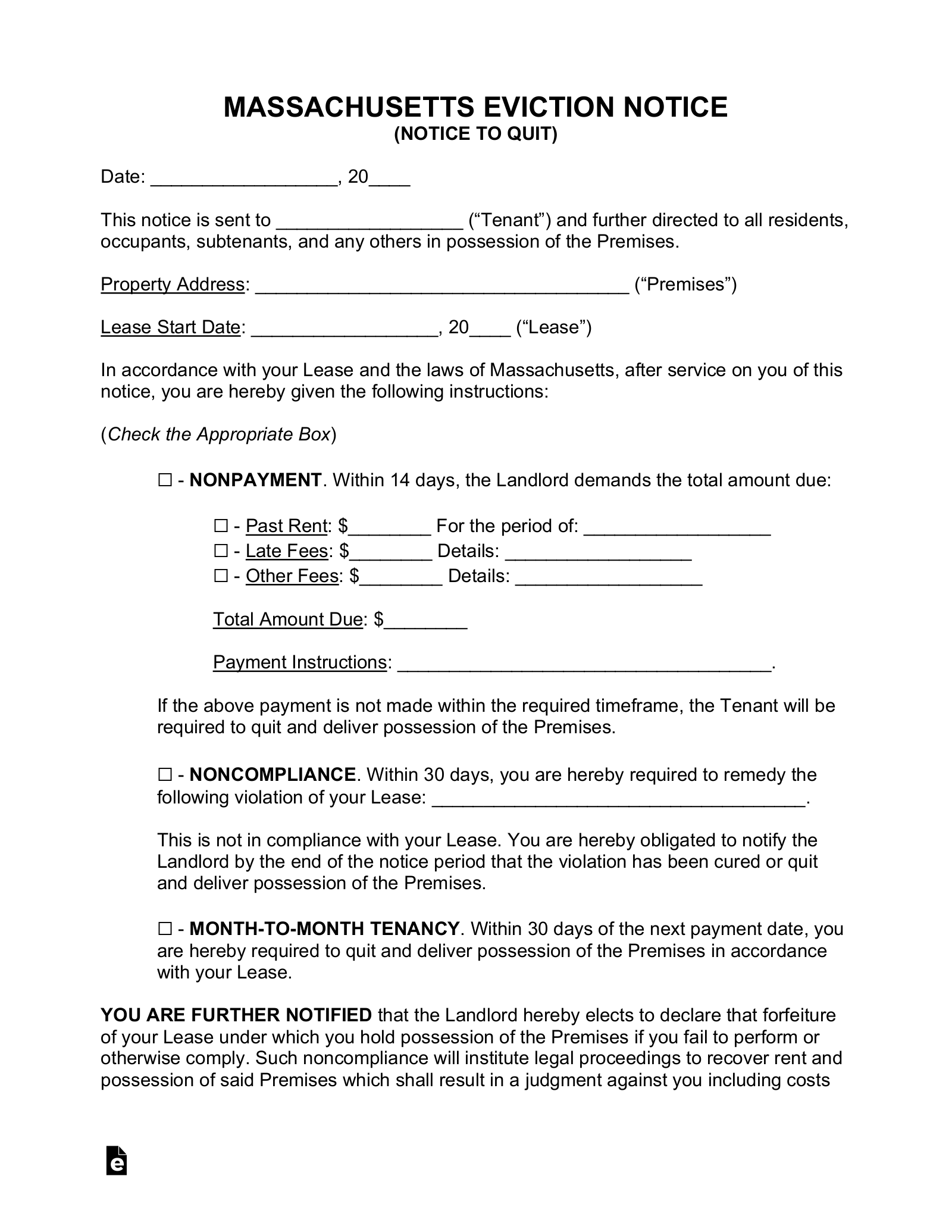Updated February 08, 2024
A Massachusetts eviction notice is a letter from a landlord informing a tenant that they are no longer in compliance with their lease. It is very important that the landlord provide requisite notice before commencing an action in court to have the tenant evicted. Once the notice period has ended, a landlord can file a Summary Process Action in court.
By Type (3)
 14-Day Notice to Quit (Non-Payment) – This form of notice is used when a tenant has not paid rent when it is due. The landlord must make sure it is received by the tenant. 14-Day Notice to Quit (Non-Payment) – This form of notice is used when a tenant has not paid rent when it is due. The landlord must make sure it is received by the tenant.
Download: PDF |
 30-Day Notice (Non-Compliance) – There is no state statute in regard to notice provided to a tenant for violating a portion of the lease; however, the Housing Court accepts 30-day notice violations in the event of a lease violation by the tenant. 30-Day Notice (Non-Compliance) – There is no state statute in regard to notice provided to a tenant for violating a portion of the lease; however, the Housing Court accepts 30-day notice violations in the event of a lease violation by the tenant.
Download: PDF |
 30-Day Notice to Quit (Month-to-Month Tenancy) – This form is used for any other legal reason to end a tenancy, including informing the tenant of the end of a month-to-month tenancy. 30-Day Notice to Quit (Month-to-Month Tenancy) – This form is used for any other legal reason to end a tenancy, including informing the tenant of the end of a month-to-month tenancy.
Download: PDF, MS Word, OpenDocument |
Table of Contents |
Court Forms
Summons and Complaint (Sample) – After issuing a notice to quit and the appropriate notice period has lapsed without action on the part of the tenant, the landlord can start a formal eviction by filing this form with the local court. This document can only be obtained from the court.
Summary Process Answer Form – After being served the landlord’s summons and complaint, the tenant may contest the eviction by filling out this form and filing it with the same court in which the case was filed.
Discovery – Once an eviction complaint has been filed, either party may use this form to view any documents that will be presented by the opposition.
How to Evict (5 steps)
- Deliver Eviction Notice to Tenant
- Fill Out Summons and Complaint
- File Papers and Serve Tenant
- File Discovery Before Hearing
- Obtain Execution and Deliver to Sheriff
1. Deliver Eviction Notice to Tenant
A landlord must first have the correct notice delivered to the tenant. It is important that the tenant receives the notice and that landlord has evidence that the tenant received the notice. Otherwise, a tenant can use not receiving notice as a defense against eviction. A landlord can use the following forms depending on the situation:
2. Fill Out Summons and Complaint
Once the requisite notice period has passed without a response from tenant, the landlord may begin proceedings by going to the local court in the area of the leased premises to obtain a Summons and Complaint. The landlord must use the form provided by the court and must pay a $5 fee when submitting.
3. File Papers and Serve Tenant
The landlord must serve the forms upon the tenant in accordance with Rule 4(d). The landlord can then make a copy of the service and file that with the court. The tenant will have the right to speak their side of the story through the Summary Process Answer Form no later than the first Monday after the entry day.
4. File Discovery Before Hearing
Before the hearing date, any of the parties may file a discovery before the first Monday after the entry day in order to view any and all documents that may be presented against them on the court date.
5. Obtain Execution and Deliver to Sheriff
If the tenant doesn’t answer or landlord receives a judgment in his or her favor, the landlord may obtain an execution eleven days after the judgment, which they can bring to the sheriff or constable the next day. The sheriff serves the execution on the tenant, which gives them 48 hours to move out before the sheriff comes in to evict.


